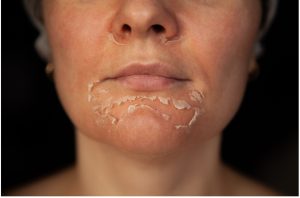
Purpose of Peeling
To exfoliate the outer layer of the skin to regenerate the facial skin and repair its beauty in a safe manner.
Benefits of Peeling

- Improve skin texture and treat aging skin
- Reduce wrinkles
- Promote skin cells regeneration
- Reduce hyperpigmentation or facial spots
- Lessens the appearance of acne scar
Types of Chemical Peeling
Chemical peeling is divided into 3 based on the depths it targets:
- Light chemical peeling: a superficial chemical peel that targets the exfoliation of the outermost layer of the skin (epidermis). It is most often used to treat fine wrinkles, acne, dry skin, or uneven skin tone.
- Medium chemical peeling: a medium chemical peel that targets the exfoliation of the epidermis up to the outermost dermis (middle layer of the skin). It is used to treat wrinkles, acne scar, and uneven skin tone. This procedure may need to be repeated to reach or maintain the desired result.
- Deep chemical peeling: a deep chemical peel that targets the exfoliation of deeper layer of the skin. Doctors may recommend this to treat deeper acne scar, wrinkles, or pre-cancerous lesion. This is often done only once to reach a certain desired result.
Side Effects of Peeling
- Redness, scabbing, swelling. These are the common side effects that occurs as part of the healing process after peeling. The duration varies from weeks to months depending on the depths of peeling.
- Changes in skin color. The treated skin may become darker (hyperpigmented) or lighter (hypopigmented) than before. Hyperpigmentation may occur in light peeling while hypopigmentation in deep peeling. However, this side effect usually occur in patients with originally darker skin.
- After peeling, there could be bacterial, viral, or fungal infection if the skin is not treated cleanly. For those with herpes, herpetic skin flare-up may occur.
- Although rare, chemical peeling may cause scarring especially on the lower part of the face. Your doctor may give you certain medications for this.
Things to Note Before Chemical Peeling
Before chemical peeling, please consult with your dermatologist first. Your doctor will first review your medical history, do some physical examinations, and discuss the problems and targets that you desire. Then the doctor will decide the regiment for your tailored peeling program. Before chemical peeling, the doctor may tell you to use certain cream and avoid certain medicines / cosmetics.
Chemical Peeling Procedure
Depending on the type of peeling, your doctor will perform different procedures. In general, your doctor will apply chemical solution onto your skin. For deep peeling, the doctor may give you IV fluids and monitor your heart rate. Usually the procedure lasts for 30 – 90 minutes.
Things to Note After Chemical Peeling

- The treated skin may become red, irritative, or swollen (depending on the depth of the peeling procedure)
- Avoid rubbing / scratching skin
- Apply skin cream according to doctor’s instructions
- Avoid direct sunlight
- Use sunscreen or moisturizer regularly according to doctor’s instructions
- Avoid using skin exfoliating products right after peeling
- Avoid certain cosmetic / make-up products for some time according to doctor’s instructions
Resources:
https://www.mayoclinic.org/tests-procedures/chemical-peel/about/pac-20393473
https://www.healthline.com/health/beauty-skin-care/chemical-peels-at-home
